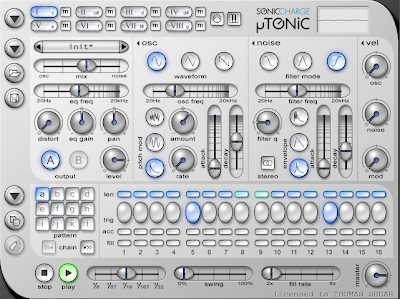
(Click image for a closer look at the settings.)
I haven't done one of these in awhile, so I thought we might be due for one. Behind the crash cymbal, the snare drum may be one of the more difficult drum sounds to synthesize convincingly. It's possible to get some semi-convincing snare sounds out of well-equipped modular synths or even a full-featured synth like the Access Virus, but for most synths, the best you're going to do is an analog drum machine type snare. And that's actually pretty damn cool. If I want a real snare sound I can sample it. So we're going to use a synth for what it does best: make cool electronic sounds. Today I'll show you how to make a synth snare sound not too unlike the Roland TR-808. I'll be doing this with Sonic Charge's super cool Microtonic drum synth plug-in, but you can get similar results from any synth that allows you to pitch modulate an oscillator with an envelope that also has a noise source.
Your typical snare drum sound sounds the way it does because it consists of the initial percussive burst of the stick hitting the head, the ringing of the shell, and the rattle of the snare itself. With this in mind, let's dig in.
1. Open up an instance of Microtonic. If you want to program a couple of notes in the sequencer on steps 5 and 13 (the backbeat), it can make it easier to hear the changes you make as you tweak. The first part we're going to concentrate on is the combination of the percussive strike and the 'tone' of the drum's resonant shell. So for the moment, set the MIX setting all the way left to OSC, so we are only hearing this part of the sound. Because this is a tonal element, we're going to use a sine wave with an envelope modulating the pitch. The first thing we need to do is set the sine wave's pitch, so look for the OSC FREQ setting and set it somewhere around 150 Hz. The 'body' of a snare sound is often somewhere in the 150-250 Hz range.
2. This doesn't sound percussive yet, though, so let's take care of that by heading down to the FREQ MOD AMOUNT knob right below the OSC FREQ section. If you go overboard with this, you're going to get into 'laser gun' types of sounds, which are cool in their own right, but not what we're after. Set this around +6.45. The FREQ MOD RATE is less important here, but if you play around with it, you'll hear the variations in timbre it can provide. I'm setting mine at 0, but you set whatever sounds right to you. By now, you should have something that sounds similar to a TR-808 conga or tom sound. So now you know how to make those, too.
3. With the strike and the tone taken care of, we need to get that snare rattle taken care of, so we need to add in some noise. (This will also contribute to the percussive element of the sound). We need to be able to hear our noise source now, so go ahead and slide the MIX slider just slightly right of the middle so we have a more or less even mix of the sine oscillator and the noise generator (slightly favoring the noise).
4. It already sounds pretty nice, but we'll tweak things just a bit. Set your noise envelope's DECAY setting to around 100-100 ms. Longer settings will give you 'doofier' sounding snares more akin to the famous Simmons sound. Microtonic defaults to a low pass filter which works nicely, but I want a crisper sound out of the noise, so I'm changing it to a highpass filter (the rightmost button at the top of the noise section). Bring the FILTER FREQ up to around 370 Hz.
If you've done everything correctly, you should have something that sounds like this:
Now that you have a halfway decent synth snare, start messing around and seeing what other variations you can come up with.




















2 comments:
This can't have effect in reality, that's what I think.
Hi guys recently found this web what do u think
Is it a good choice for producer ?
www.lucidsamples.com
Post a Comment